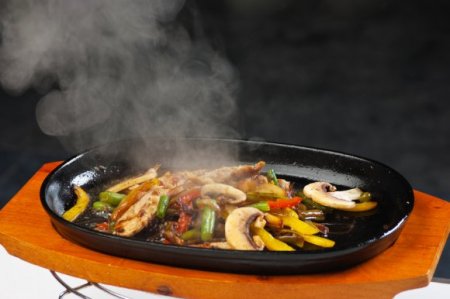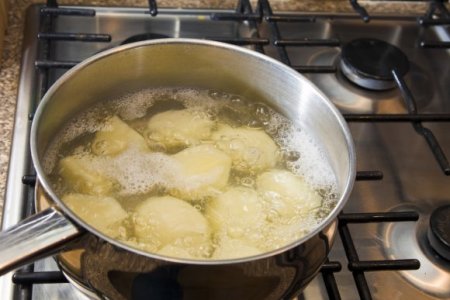Heat treatment and vitamins: how the high temperature affects the useful properties of the products
As vitamins tolerate heat treatment?
Vitamin A. Found in liver, garlic, butter, broccoli, seaweed, carrots, tomatoes, green onions and dill. Heat treatment destroys 30% of its biological properties. Particularly intense vitamin A is destroyed during roasting, drying under the influence of ultraviolet rays. Well preserved by sterilization to products at a temperature of 120 degrees.
Vitamin B1. Contained in oatmeal, millet, pork, liver, buckwheat, pasta. Particularly sensitive to cooking (lose up to 45% good), frying (up 42%) and fire (30%). Loses activity at temperatures above 120 degrees.
Vitamin B2. Found in liver, mushrooms, chicken eggs, Gusyatin. If you cook these products, you will lose up to 43% of useful properties, so other methods of cooking - is preferable (to extinguish lost only 10% of the biological activity of vitamin).
Vitamin B6. Contained in the beans, tuna, mackerel, sweet pepper, chicken meat, spinach, cabbage. This vitamin is really resistant to high temperature and cooking these products even useful, as well B6 releases its active ingredients.
Vitamin B9. Found in liver, beans, spinach, broccoli, barley grits, white mushrooms and champignons. Poor tolerate any heat treatment, losing up to 90% of its properties. Especially significant loss of the vitamin during cooking and conservation.
Vitamin C. Contains wild rose, sweet peppers, cabbage, oranges, lemons, garlic, spinach. No wonder these products are often eaten fresh: otvarivaya cabbage, we lose up to 90% of vitamin and quenching destroys it by 50%. Each subsequent heat treatment of the ready meals by 30% reduces the content of vitamin C.
Vitamin D. Contains sea bass, liver, chicken eggs, butter. It tolerates the heat treatment if the temperature does not exceed 100 degrees. Destroyed largely due to exposure to oxygen, therefore easily withstand sterilization products.
Vitamin E. Contains wild rose, salmon, perch, wheat, dried apricots, prunes, oatmeal and barley groats. Almost is not destroyed by heat, but suffers from direct sunlight.
Vitamin PP. Contained in poultry meat, rabbit, beef, fish and liver. Excellent transfers any heat treatment, canning and freezing. These products will lose from 5 to 40% of the beneficial properties of vitamin, as if they were not prepared.
How to keep useful properties of the products?
In order not to lose in the process of cooking all the vitamins, monitor the temperature: it should not exceed 100 degrees. This will destroy pathogens, but retain the biological properties of the products.
It is necessary to minimize the heat treatment. Vegetables cook steamed or baked. Do not cut them too small, do not use a grater or blender - optimally, if the products are cleaned and cut immediately before use.
Each subsequent heating of food reduces its favor. Try to cook one meal, do not freeze the products and do not store them too long.
Vitamin A. Found in liver, garlic, butter, broccoli, seaweed, carrots, tomatoes, green onions and dill. Heat treatment destroys 30% of its biological properties. Particularly intense vitamin A is destroyed during roasting, drying under the influence of ultraviolet rays. Well preserved by sterilization to products at a temperature of 120 degrees.
Vitamin B1. Contained in oatmeal, millet, pork, liver, buckwheat, pasta. Particularly sensitive to cooking (lose up to 45% good), frying (up 42%) and fire (30%). Loses activity at temperatures above 120 degrees.
Vitamin B2. Found in liver, mushrooms, chicken eggs, Gusyatin. If you cook these products, you will lose up to 43% of useful properties, so other methods of cooking - is preferable (to extinguish lost only 10% of the biological activity of vitamin).
Vitamin B6. Contained in the beans, tuna, mackerel, sweet pepper, chicken meat, spinach, cabbage. This vitamin is really resistant to high temperature and cooking these products even useful, as well B6 releases its active ingredients.
Vitamin B9. Found in liver, beans, spinach, broccoli, barley grits, white mushrooms and champignons. Poor tolerate any heat treatment, losing up to 90% of its properties. Especially significant loss of the vitamin during cooking and conservation.
Vitamin C. Contains wild rose, sweet peppers, cabbage, oranges, lemons, garlic, spinach. No wonder these products are often eaten fresh: otvarivaya cabbage, we lose up to 90% of vitamin and quenching destroys it by 50%. Each subsequent heat treatment of the ready meals by 30% reduces the content of vitamin C.
Vitamin D. Contains sea bass, liver, chicken eggs, butter. It tolerates the heat treatment if the temperature does not exceed 100 degrees. Destroyed largely due to exposure to oxygen, therefore easily withstand sterilization products.
Vitamin E. Contains wild rose, salmon, perch, wheat, dried apricots, prunes, oatmeal and barley groats. Almost is not destroyed by heat, but suffers from direct sunlight.
Vitamin PP. Contained in poultry meat, rabbit, beef, fish and liver. Excellent transfers any heat treatment, canning and freezing. These products will lose from 5 to 40% of the beneficial properties of vitamin, as if they were not prepared.
How to keep useful properties of the products?
In order not to lose in the process of cooking all the vitamins, monitor the temperature: it should not exceed 100 degrees. This will destroy pathogens, but retain the biological properties of the products.
It is necessary to minimize the heat treatment. Vegetables cook steamed or baked. Do not cut them too small, do not use a grater or blender - optimally, if the products are cleaned and cut immediately before use.
Each subsequent heating of food reduces its favor. Try to cook one meal, do not freeze the products and do not store them too long.

